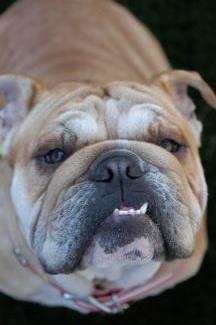Bulldog face

I had a stark realization one day in the clinic. I think I had been out in practice for several years, so my mind was a little less preoccupied with the day-to-day tasks of medicine and I had a little mental leeway to think about big-picture issues in veterinary medicine. The thought was something like this: “Wow, a lot of what I do is trying to deal with bad genetics.”
Right off the bat, I don’t want to give the impression that I don't think of my patients as beloved family members. Dogs are more than just a bag of chromosomes; they are individuals who bring much joy and love into the lives of their families. But much of what ails modern pets - not all, much; that’s less than all - came about through someone, at some point, thinking, “Wow, that trait (insert here: short and cute nose, coat color, skills at protecting a family) sure is nice and I want more dogs with it.” And it all unravels from there.
Geneticists call this artificial selection to differentiate it from the process by which animals evolve in nature: natural selection. While natural selection favors (in general) individuals whose traits make them more likely to have offspring, artificial selection chooses based on appearance or one specific function. So, you get more dogs that look a certain way – and that may come with problems.
Genes tend to run in groups. The gene for having a tan and black coat, such as we see with German Shepherd Dogs, may also decide to travel the genome along with one that causes hemangiosarcoma, a deadly and aggressive form of cancer. If you unwittingly choose your German Shepherds to have a consistently lovely black and tan coat, you might also be concentrating all those cancer genes in one bloodline. It’s an unfortunate side effect of breeding dogs to look a certain way.
The way a dog functions, while also related to genes, is also important. Pugs and other snub-nosed breeds are adorable (I grew up with a pug and they can be some of the nicest dogs ever) and have been bred for centuries to look like they ran full-speed into a parked car. But with that look comes the risk of overheating due to inadequate heat exchange. Dogs can’t sweat, so they get rid of excess heat through panting. Hard to pant through the tiny (but cute!) little holes in that little nose. To make matters worse, many snub-nosed breeds also have a too-small trachea (windpipe) to breathe through, so the overheating risk intensifies.
While attitude and demeanor are an important part of what makes each dog breed special, the primary distinguishing factor is how they look. Again, taking a page from the geneticist’s playbook, that’s called a phenotype: the outward appearance of any living thing. The genetic makeup is known as a genotype. If we want healthier pets and wish to avoid scourges of the dog world, such as cancer, bloat, autoimmune diseases and whole panoply of disorders that likely have a basis in a dog’s genes, we should select dogs to breed based on genotype (or at least family history, which is a consequence of genotype) instead of purely on looks alone.
Some responsible breed clubs and breeders are already doing this. They are scanning bloodlines and coordinating efforts to reduce the effects of certain diseases on dogs. This is admirable, but it is a huge undertaking and might be beyond the abilities of a single person who wants to breed a particular dog. I don’t have a solution to the bigger issue of how to breed healthier dogs so they can live longer, disease-free lives, but raising awareness is surely part of the fix.
1 Comment
Caroline Mitter
October 17, 2017